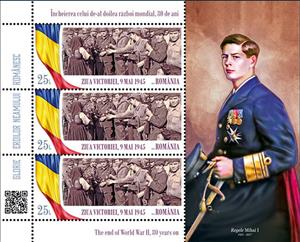Mini Sheet: Soldiers Liberating Village in Transylvania (Romania 2025)
Soldiers Liberating Village in Transylvania (Romania 2025)
09 May (Romania ) within release End of World War II, 80 Years (2025) goes into circulation Mini Sheet Soldiers Liberating Village in Transylvania face value 3*25 Romanian leu
| Mini Sheet Soldiers Liberating Village in Transylvania in catalogues | |
|---|---|
| Colnect codes: | Col: RO 2025.05.09-01a |
Mini Sheet is horizontal format.
Also in the issue End of World War II, 80 Years (2025):
- Mini Sheet - Soldiers Liberating Village in Transylvania face value 25;
- Mini Sheet - Soldiers Liberating Village in Transylvania face value 3*25;
- Stamp - Victory Celebration in Bucharest face value 30;
- Souvenir Sheet - Victory Celebration in Bucharest face value 30;
Mini Sheet Soldiers Liberating Village in Transylvania it reflects the thematic directions:
Famous People refers to the fame and public attention accorded by the mass media to individuals or groups or, occasionally, animals, but is usually applied to the persons or groups of people (celebrity couples, families, etc.) themselves who receive such a status of fame and attention. Celebrity status is often associated with wealth (commonly referred to as fame and fortune), while fame often provides opportunities to make money.
A flag is a piece of fabric (most often rectangular or quadrilateral) with a distinctive design that is used as a symbol, as a signaling device, or as decoration. The term flag is also used to refer to the graphic design employed, and flags have since evolved into a general tool for rudimentary signalling and identification, especially in environments where communication is similarly challenging (such as the maritime environment where semaphore is used). National flags are patriotic symbols with varied wide-ranging interpretations, often including strong military associations due to their original and ongoing military uses. Flags are also used in messaging, advertising, or for other decorative purposes. The study of flags is known as vexillology, from the Latin word vexillum, meaning flag or banner.
King is the title given to a male monarch in a variety of contexts. The female equivalent is queen regnant (while the title of queen on its own usually refers to the consort of a king). In the context of prehistory, antiquity and contemporary indigenous peoples, the title may refer to tribal kingship. Germanic kingship is cognate with Indo-European traditions of tribal rulership (c.f. Indic rājan, Gothic reiks, and Old Irish rí, etc.) In the context of classical antiquity, king may translate Latin rex or either Greek archon or basileus. In classical European feudalism, the title of king as the ruler of a kingdom is understood as the highest rank in the feudal order, potentially subject, at least nominally, only to an emperor (harking back to the client kings of the Roman Empire). In a modern context, the title may refer to the ruler of one of a number of modern monarchies (either absolute or constitutional). The title of king is used alongside other titles for monarchs, in the West prince, emperor, archduke, duke or grand duke, in the Middle East sultan or emir; etc. Kings, like other royalty, tend to wear purple because purple was an expensive color to wear in the past.



